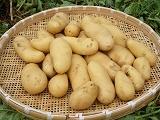Mishima Bareisho
| Registration Number | 18 |
|---|---|
| Name of the GI | Mishima Bareisho, MISHIMA BAREISHO |
| Class | Vegetables/ Cereal grains/Pulses |
| Date of Protection | 2016/10/12 |
| Producing Area |
Shizuoka Prefecture
Mishima City and parts of Kannami Town. Precisely, they are located in the West side of the Hakone Mountain in Mishima City (Sano, Tokura, Sawachi, Kawaharagaya-yamada, Kawaharagaya-ozawa, Kawaharagaya-motoyamanaka, Tsukahara-shinden, Ichinoyama-shinden, |
| Applicant - Name and Address | Fuji-Izu Japan Agricultural Cooperatives 415-1 Aza Kamishoji, Shimokanuki, Numazu City, Shizuoka Prefecture |
MISHIMA BAREISHO is a variety of May Queen produced in Mishima City and the Kannami-cho area of Tagata District in Shizuoka Prefecture which lie at the western foot of Hakone. It has a beautiful glossy surface with no skin scratches, a creamy texture which does not easily disintegrate like that of the May Queen, and soft, flaky mouthfeel with a sweet flavor like that of the Danshaku (baron) variety.
In the cultivation of MISHIMA BAREISHO, the surface layer of soil is covered with a vinyl sheet, and the potatoes are harvested carefully one by one so as not to damage the potato skin. For one to two weeks after harvesting, they are stored by drying in a cool, dark place with good ventilation to mature. This gives it sweetness and a soft, flakey texture, and increases its storage life. If the potato is stored while its surface is not dried, the surface sweats and is unable to breathe. This causes bruising, rot and disease. By keeping it exposed to the wind while drying it out, the quality is maintained even after consumers have purchased it.
The soil at the western foot of Hakone, the production area, consists of strata in which volcanic ash called black soil has changed into a black eroded soil layer over a long period of time. Because the layer of cultivated soil is deep and soft, it has excellent water permeability, breathability and water retention.
The ground temperature during the gemination period from February to March, is 10 to 15°C when the soil is covered with sheets, and the daily average temperature in the subsequent growing season is 13 to 20°C. Also, during the cultivation period, there is moderate precipitation that keeps the soil from drying out too much. These are good conditions for growing potatoes that require moderate moisture and a slightly chilly climate.
Furthermore, the south-facing slopes of the fields in the area facilitate the long daylight hours and good drainage that make the region even more suitable for growing potatoes. Since it is difficult to use large harvesting machines on a sloping field, each potato is carefully picked one by one.


